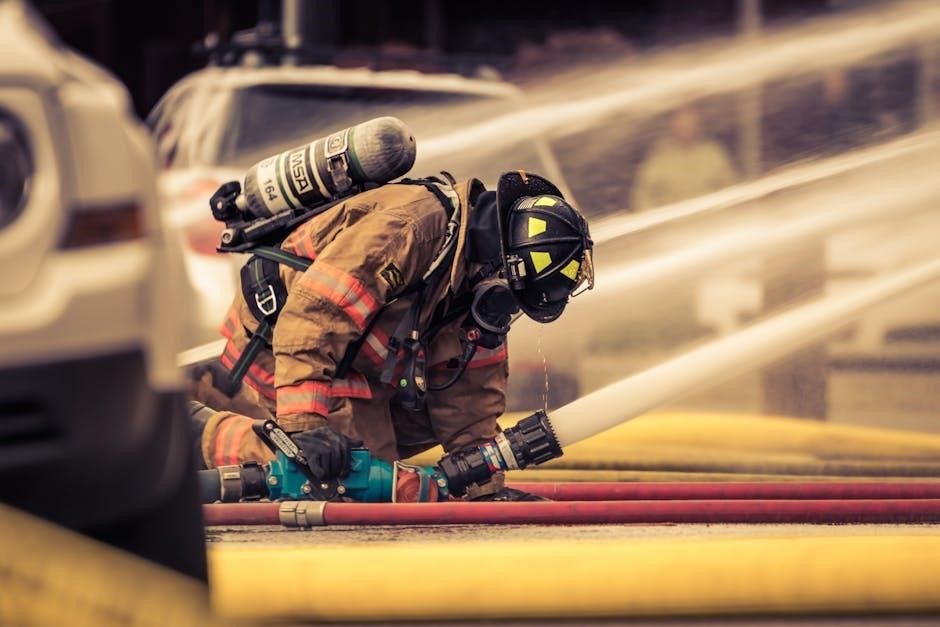
The Wright Brothers Drill Test evaluates cadets’ mastery of military-style drill movements, named after aviation pioneers, assessing leadership and teamwork, available in PDF format for evaluation.
1.1 Overview of the Wright Brothers Drill Test
The Wright Brothers Drill Test is a formal evaluation assessing cadets’ mastery of military-style drill movements and leadership skills. Named after the aviation pioneers, it is part of the Wright Brothers milestone exam. The test includes both a written examination and a practical drill performance, designed to evaluate proficiency in ceremonies and drill techniques. Cadets must demonstrate precision, discipline, and teamwork during the practical portion, which is a summative assessment of their skills. The test is available in PDF format, ensuring accessibility for cadets preparing for the evaluation. Successful completion is a key requirement for advancing in the Civil Air Patrol program, reflecting the legacy of the Wright Brothers’ contributions to aviation and leadership.
1.2 Historical Background of the Wright Brothers
The Wright Brothers, Orville and Wilbur Wright, were pioneering American inventors and aviation trailblazers. Born in the late 19th century, they grew up with a passion for mechanics and innovation. Their groundbreaking achievement came on December 17, 1903, when they successfully flew the world’s first powered, heavier-than-air aircraft at Kitty Hawk, North Carolina. This historic flight revolutionized transportation and military capabilities, laying the foundation for modern aviation. Their meticulous approach to engineering and systematic testing exemplified precision and discipline, qualities that are honored in the Wright Brothers Drill Test. This test, detailed in a downloadable PDF, commemorates their legacy by assessing cadets’ mastery of drill movements and leadership skills, reflecting the values of innovation and perseverance that defined the Wright Brothers’ journey.
1.3 Importance of the Drill Test in Modern Context
The Wright Brothers Drill Test holds significant relevance in today’s aviation and military training landscapes. It emphasizes discipline, precision, and leadership, which are essential for modern aviators and cadets. By mastering drill techniques, individuals develop the mental and physical rigor required for high-stakes environments. The test also fosters teamwork, a cornerstone of successful aviation operations. In a contemporary context, the drill test ensures that future pilots and officers uphold the legacy of innovation and excellence established by the Wright Brothers. The Wright Brothers Drill Test PDF serves as a vital resource, providing insights into the test’s structure and significance, while also preparing cadets for the challenges of modern aviation and military service.

Historical Background of the Wright Brothers

The Wright Brothers, Orville and Wilbur, were pioneering inventors who designed, built, and flew the world’s first successful airplane. Their innovative approach and perseverance revolutionized aviation history.
2.1 The Wright Brothers’ Contributions to Aviation
The Wright Brothers made groundbreaking contributions to aviation by successfully designing, constructing, and flying the first powered, heavier-than-air aircraft. Their innovative three-axis control system allowed for precise flight maneuverability, overcoming earlier challenges in stability. Through meticulous wind tunnel experiments, they developed wing shapes and control surfaces that maximized lift and control. Their achievements laid the foundation for modern aviation, influencing both military and commercial aircraft design. The Wright Brothers’ perseverance and ingenuity not only revolutionized transportation but also inspired future generations of engineers and pilots. Their work remains a cornerstone of aviation history, emphasizing the importance of precision and innovation in aerospace development.
2.2 The Evolution of Drill Tests in Aviation History
The evolution of drill tests in aviation history reflects the growing complexity and precision required in flight training. Originating from military traditions, drill tests were adapted by the Wright Brothers to standardize aviation procedures. Early drills focused on manual dexterity and coordination, essential for operating primitive aircraft. As aviation technology advanced, so did the drills, incorporating more sophisticated maneuvers and safety protocols. World War I and II further formalized these tests, emphasizing teamwork and discipline. Today, modern aviation training integrates advanced simulation tools and rigorous evaluation criteria, ensuring pilots meet high standards of competence. The Wright Brothers’ legacy influences these drills, which remain critical for maintaining safety and professionalism in aviation.
2.3 The Legacy of the Wright Brothers in Modern Drill Practices
The Wright Brothers’ innovative spirit and meticulous attention to detail have left an indelible mark on modern drill practices. Their emphasis on precision, teamwork, and continuous improvement laid the foundation for contemporary aviation training. Today, their legacy is evident in the structured approach to drill tests, which combine theoretical knowledge with practical skills. The brothers’ focus on hands-on experimentation and problem-solving inspires modern cadets to embrace challenges with creativity and resilience. Additionally, their commitment to safety and excellence continues to influence the high standards expected in aviation training. The Wright Brothers’ contributions remain a cornerstone of modern drill practices, ensuring that their pioneering spirit endures in the next generation of aviators.

Structure and Components of the Wright Brothers Drill Test
The Wright Brothers Drill Test is a comprehensive assessment comprising written exams, practical drills, and evaluation criteria to ensure proficiency and adherence to aviation standards.
3.1 Written Examination Portion
The written examination portion of the Wright Brothers Drill Test assesses cadets’ theoretical knowledge of aviation principles, drill protocols, and historical context. This section includes multiple-choice questions, short-answer responses, and essay prompts. Topics range from the fundamentals of flight mechanics to the historical contributions of the Wright Brothers. Cadets are evaluated on their understanding of safety procedures, aircraft handling, and drill commands. The exam is timed, and answers must be concise and accurate. Study materials, such as official drill manuals and practice tests, are provided to help cadets prepare. The written portion is a critical component, as it determines a cadet’s grasp of foundational concepts before advancing to practical drills. Proper time management and thorough study habits are essential for success in this phase.

3.2 Practical Drill Evaluation
The practical drill evaluation assesses cadets’ ability to execute drill commands with precision and coordination. This portion simulates real-world aviation scenarios, testing alignment, posture, and synchronization within teams. Cadets are evaluated on their mastery of specific drill techniques, such as marching, turning, and saluting, while maintaining discipline and focus. The evaluation is conducted in a controlled environment, with instructors observing every movement. Team drills emphasize unity and cohesion, while individual performances highlight personal mastery. The practical test adheres to strict protocols outlined in the Wright Brothers Drill Test manual, ensuring fairness and consistency. This phase is crucial for developing the skills and composure required in aviation and military traditions, fostering teamwork and leadership among cadets.
3.3 Scoring and Evaluation Criteria
The Wright Brothers Drill Test uses a standardized scoring system to evaluate cadets’ performance objectively. Each drill command is assessed based on execution, precision, and adherence to protocols. Scores are allocated according to predefined criteria, with deductions for errors such as misalignment or improper technique. The evaluation process is transparent, ensuring fairness and consistency. Cadets receive detailed feedback highlighting strengths and areas for improvement. The scoring system is weighted, with emphasis on teamwork, leadership, and discipline. A minimum score is required to pass, and results are used to determine eligibility for advanced training and promotions. This rigorous evaluation ensures cadets meet the high standards expected in aviation and military traditions.

Preparation and Study Materials for the Drill Test
Cadets utilize detailed manuals, instructional guides, and online resources to prepare. Practice exercises and visual aids enhance understanding and mastery of drill techniques effectively.
4.1 Recommended Study Resources for Cadets
Cadets preparing for the Wright Brothers Drill Test should utilize official drill manuals, instructional guides, and online resources. The Wright Brothers Drill Test PDF is a comprehensive study aid, offering detailed procedures and visual demonstrations. Additionally, practice manuals and training videos provide step-by-step instructions to master drill techniques. Cadets are encouraged to review historical aviation materials to understand the test’s origins and significance. Structured study plans and flashcards can enhance retention of key concepts. Lastly, participating in group study sessions and seeking feedback from instructors can further improve readiness and confidence for the test.
4.2 Practice Exercises and Drill Manuals
Effective preparation for the Wright Brothers Drill Test involves regular practice exercises and the use of detailed drill manuals. The Wright Brothers Drill Test PDF includes practice routines and diagrams to help cadets master specific drills. Manual exercises focus on precision, timing, and coordination, essential for achieving high scores. Cadets should also engage in group practice to refine teamwork and synchronization. Supplementary materials, such as instructional videos and step-by-step guides, can enhance understanding and execution. Consistent practice ensures familiarity with the test format and builds confidence. Regularly reviewing and perfecting these exercises is crucial for success in the practical evaluation portion of the drill test.
4.3 Tips for Mastering Drill Techniques
Mastering drill techniques requires dedication, focus, and consistent practice. Start by understanding the fundamentals outlined in the Wright Brothers Drill Test PDF, ensuring proper posture, alignment, and movement precision. Practice regularly, even for short durations, to build muscle memory and coordination. Break down complex drills into smaller segments and gradually combine them. Use the manual’s visual aids to perfect your form. Seek feedback from instructors or peers to identify and correct errors. Stay mentally prepared by visualizing success and maintaining a positive attitude. Incorporate physical conditioning to enhance stamina and endurance. By following these tips, cadets can excel in their drill performance and achieve higher scores during the test.

The Significance of the Wright Brothers Drill Test
The Wright Brothers Drill Test emphasizes leadership, teamwork, and discipline, reflecting the aviation pioneers’ legacy. It bridges historical traditions with modern training, fostering excellence in cadets.
5.1 Leadership Development Through Drill Training
The Wright Brothers Drill Test plays a crucial role in fostering leadership skills among cadets. By mastering precise movements and commands, individuals develop discipline and confidence, essential for guiding teams. Drill training encourages cadets to take charge, communicate clearly, and make decisions under pressure, mirroring the leadership qualities demonstrated by the Wright Brothers. The structured environment of the drill test helps cadets understand the importance of unity and coordination, preparing them to lead effectively in high-stakes situations. This training not only honors the brothers’ innovative spirit but also equips future leaders with the resilience and strategic thinking needed to excel in aviation and beyond.
5.2 Teamwork and Discipline in Drill Exercises
Drill exercises in the Wright Brothers Drill Test emphasize teamwork and discipline, mirroring the collaborative spirit of the Wright Brothers. Cadets learn to synchronize their actions, relying on one another to achieve flawless execution. This fosters a sense of unity and shared responsibility, as each member’s performance impacts the entire team. Discipline is cultivated through repetitive practice, attention to detail, and adherence to commands. These exercises prepare cadets for the precision required in aviation, where coordination and trust among crew members are vital. By mastering teamwork and discipline, cadets honor the legacy of the Wright Brothers while developing skills essential for success in military and aviation careers.
5.3 The Role of Drill in Military and Aviation Traditions
Drill has long been a cornerstone of military and aviation traditions, fostering discipline, precision, and unity among personnel. The Wright Brothers Drill Test reflects these values, drawing inspiration from the structured practices of early aviation training. Drill exercises symbolize the meticulous preparation and coordination required in flight operations, echoing the Wright Brothers’ attention to detail during their pioneering work. In military contexts, drill reinforces hierarchy, teamwork, and adherence to protocol, all of which are critical in high-stakes aviation environments. By incorporating drill into their training, cadets honor the traditions established by the Wright Brothers while building the skills and mindset necessary for excellence in aviation and military service.

Challenges and Difficulties in the Drill Test
Cadets face rigorous physical and mental demands, precision requirements, and high expectations, making the Wright Brothers Drill Test both challenging and demanding to master successfully.
6.1 Common Mistakes Cadets Make During the Test
Cadets often struggle with maintaining precise synchronization during group drills, leading to deductions. Additionally, improper posture and foot placement are frequent errors; Many cadets also fail to execute commands promptly, causing delays. Overthinking or hesitating during sequences can disrupt rhythm and accuracy. Inadequate practice of hand movements and alignment further contributes to mistakes. Some cadets misinterpret drill manual instructions, resulting in incorrect formations. Lastly, poor time management during the test can lead to rushed or missed commands, impacting overall performance. Addressing these issues requires focused practice and attention to detail to ensure flawless execution.
6.2 Physical and Mental Demands of the Drill Test
The Wright Brothers Drill Test places significant physical demands on cadets, requiring stamina, strength, and coordination. Maintaining precise posture and executing intricate movements for extended periods can lead to fatigue. Mentally, cadets must remain focused to follow complex commands and sequences, often under pressure. Memory plays a critical role, as cadets must recall drill sequences accurately. The test also demands composure, as mistakes can occur if cadets lose concentration. Balancing physical endurance and mental sharpness is essential for success. Cadets must prepare thoroughly to meet these challenges, ensuring they can perform flawlessly even when exhausted or stressed.
6.3 Strategies to Overcome Challenges
To excel in the Wright Brothers Drill Test, cadets must adopt effective strategies. Consistent practice is crucial, as repetition builds muscle memory and precision. Breaking complex drills into smaller, manageable parts allows for focused improvement. Mental preparation, such as visualization and positive affirmations, can enhance confidence and focus. Seeking feedback from instructors helps identify and correct mistakes. Additionally, staying physically fit through regular exercise improves stamina and coordination. Time management and organization are vital to balance study and practice. Lastly, maintaining a positive mindset and learning from setbacks fosters resilience. By combining these strategies, cadets can overcome challenges and achieve excellence in the drill test.

Evaluation and Results of the Drill Test

Evaluation combines written and practical performance assessments. Results categorize cadets based on precision, leadership, and adherence to drill standards. Detailed metrics ensure transparency, guiding future training and promotions.
7.1 How Results Are Used for Cadet Promotions
The results of the Wright Brothers Drill Test play a pivotal role in cadet promotions. Scores from both written and practical evaluations are combined to determine a cadet’s overall performance. High scores in areas such as precision, leadership, and adherence to drill standards significantly enhance promotion prospects. The test is designed to assess a cadet’s readiness for advanced roles, with results serving as a key indicator of their ability to lead and perform under pressure. Promotions are typically awarded to those who demonstrate exceptional mastery of drill techniques and a deep understanding of aviation traditions. The evaluation process ensures that only the most qualified cadets progress to higher ranks.
7.2 Feedback and Improvement Opportunities
The Wright Brothers Drill Test provides cadets with detailed feedback to identify areas for improvement. Instructors review performance, offering insights into strengths and weaknesses. This feedback is crucial for cadets to refine their drill techniques and enhance their understanding of aviation protocols. Specific areas of improvement are highlighted, such as precision in movements, command execution, and adherence to safety standards. Cadets are encouraged to use this feedback to focus their practice sessions. Additionally, the test results include recommendations for further study or training, ensuring cadets can address gaps in their knowledge or skills. This process fosters continuous growth and prepares cadets for future challenges in their aviation careers.
7.3 The Impact of Drill Test Performance on Future Training
The performance in the Wright Brothers Drill Test significantly influences a cadet’s future training trajectory. High scores demonstrate readiness for advanced aviation training, while lower results may necessitate additional practice or remedial instruction. The test identifies cadets with leadership potential, qualifying them for specialized programs or roles. Conversely, struggles in the drill test may indicate areas requiring focused improvement before progressing. This evaluation ensures that only well-prepared cadets advance, maintaining high standards in aviation training. Strong performance also builds confidence and discipline, essential for future challenges. Thus, the drill test serves as a critical checkpoint, shaping individual training paths and ensuring cadets are adequately equipped for their roles in aviation and military traditions.
The Wright Brothers Drill Test remains a cornerstone of aviation training, emphasizing leadership, teamwork, and discipline. Its legacy continues to inspire and prepare cadets for future challenges in aviation and military traditions.
8.1 Summary of Key Points
The Wright Brothers Drill Test is a pivotal assessment in aviation training, reflecting the legacy of Orville and Wilbur Wright. It evaluates cadets’ mastery of drill techniques, leadership skills, and teamwork. The test comprises written and practical components, ensuring a comprehensive evaluation of discipline and precision. Preparation involves rigorous study of manuals, practice exercises, and adherence to historical aviation traditions. The test’s significance lies in its ability to foster leadership, teamwork, and adherence to military and aviation standards. Challenges include physical demands and mental focus, but strategies like consistent practice and feedback can help overcome them. Ultimately, the test serves as a cornerstone for cadet development, shaping future leaders in aviation and beyond.
8.2 Final Thoughts on the Importance of the Wright Brothers Drill Test
The Wright Brothers Drill Test holds profound significance in aviation training, honoring the pioneering spirit of Orville and Wilbur Wright. It serves as a cornerstone for developing discipline, leadership, and teamwork among cadets, ensuring they meet the high standards of aviation traditions. By mastering drill techniques, cadets build a strong foundation for their future roles in aviation and military service. The test not only evaluates skill but also fosters a sense of pride and responsibility, reflecting the Wright Brothers’ legacy of innovation and excellence. Its continued relevance underscores its importance in shaping the next generation of aviation leaders, maintaining the integrity of historical practices while preparing for modern challenges.